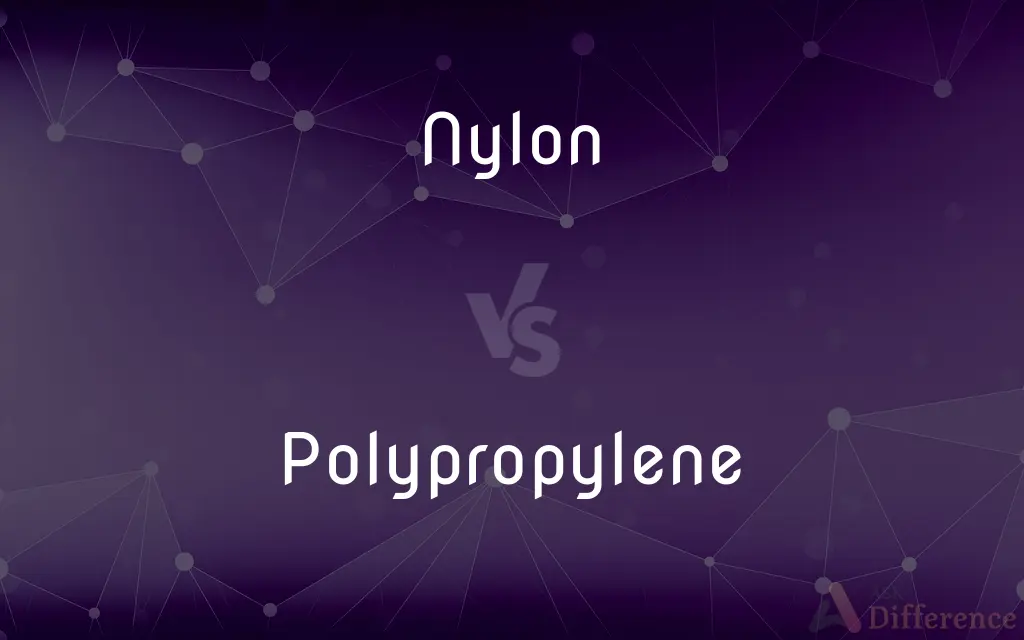Nylon vs. Polypropylene — What's the Difference?
By Tayyaba Rehman — Updated on October 26, 2023
Nylon is a synthetic polymer primarily used for textiles, while polypropylene is a thermoplastic polymer used in packaging, textiles, and more. Both are durable, but they have distinct properties and applications.

Difference Between Nylon and Polypropylene
Table of Contents
ADVERTISEMENT
Key Differences
Nylon is a versatile synthetic polymer, often recognized for its use in creating fabrics, ropes, and nets. It was initially designed to replace silk and has excellent elasticity and strength. On the contrary, polypropylene is a type of thermoplastic polymer, predominantly used in packaging, automotive components, and consumer goods. It's recognized for its resistance to chemicals and its flexibility.
In the textile industry, nylon holds a significant place due to its resilience, elasticity, and silky texture. It's used in various clothing items, including hosiery and swimwear. In contrast, while polypropylene is also employed in textiles, it's typically for items like outdoor and sportswear, mainly because of its moisture-wicking properties which make it ideal for situations where one might sweat.
From a chemical standpoint, nylon is an aliphatic polyamide, which means its molecules have both amine and acid groups. This combination gives it a unique structure and strength. In juxtaposition, polypropylene belongs to the polyolefin group and has a simpler structure, consisting of just carbon and hydrogen, leading to its high chemical resistance.
Another interesting contrast lies in their environmental impact. Nylon production can be more environmentally taxing due to the use of petrochemicals. Additionally, it's less recyclable compared to polypropylene. Polypropylene, being widely recyclable, often finds its way back into the consumer market as recycled products, making it somewhat more eco-friendly.
Comparison Chart
Main Use
Textiles, ropes, nets.
Packaging, automotive, textiles.
ADVERTISEMENT
Chemical Structure
Aliphatic polyamide.
Polyolefin.
Texture
Silky and smooth.
Varies; can be rough or smooth.
Environmental Impact
More taxing; less recyclable.
Widely recyclable; more eco-friendly.
Resistance
Good resistance to wear and abrasion.
Excellent chemical resistance.
Compare with Definitions
Nylon
A synthetic polymer used primarily in textiles.
The jacket was made of 100% nylon and repelled water effectively.
Polypropylene
Known for its high chemical resistance.
Polypropylene pipes are popular due to their resistance to most solvents.
Nylon
A material known for its elasticity and strength.
Nylon ropes are preferred for climbing due to their durability.
Polypropylene
Frequently used in packaging and consumer goods.
The reusable shopping bag was made of woven polypropylene.
Nylon
A polymer consisting of amine and acid groups.
Nylon has a unique chemical structure that gives it resilience.
Polypropylene
A widely recyclable material.
The community emphasized recycling polypropylene products to reduce waste.
Nylon
A substitute developed to mimic silk.
The nylon stockings were almost as shiny and soft as those made of silk.
Polypropylene
A thermoplastic polymer used in diverse applications.
The container was made of polypropylene to ensure it didn't react with the stored chemicals.
Nylon
Nylon is a generic designation for a family of synthetic polymers composed of polyamides (repeating units linked by amide links). Nylon is a silk-like thermoplastic, generally made from petroleum, that can be melt-processed into fibers, films, or shapes.
Polypropylene
Polypropylene (PP), also known as polypropene, is a thermoplastic polymer used in a wide variety of applications. It is produced via chain-growth polymerization from the monomer propylene.
Nylon
Any of a family of high-strength, resilient synthetic polymers, the molecules of which contain the recurring amide group CONH.
Polypropylene
A synthetic resin which is a polymer of propylene, used chiefly for films, fibres, or moulding materials
High-impact polypropylene
Polypropylene underwear
Nylon
Cloth or yarn made from one of these synthetic materials.
Polypropylene
Any of various thermoplastic polymers of propylene. They are hard and tough, and are used to make molded articles and fibers.
Nylon
Nylons Stockings made of one of these synthetic materials.
Polypropylene
A fabric of fibers made from any of these polymers.
Nylon
Originally, the DuPont company trade name for polyamide, a copolymer whose molecules consist of alternating diamine and dicarboxylic acid monomers bonded together; now generically used for this type of polymer.
Polypropylene
A thermoplastic resin made by the polymerization of propylene, and used for films, fibres, or moulding materials. Also known as polypropene.
Nylon
(in the plural) A stocking originally fabricated from nylon; also used generically for any long, sheer stocking worn on a woman's legs.
I tore a hole in my nylons while walking home through the woods.
Polypropylene
A polymer of propylene used as a thermoplastic molding material
Nylon
(perjoratively, by comparison to silk) A Queen's Counsel, King's Counsel or Senior Counsel who was appointed as a courtesy, rather than on merit.
Polypropylene
A member of the polyolefin group.
Polypropylene has a simple structure, contributing to its versatility.
Nylon
Any of several thermoplastic polyamide plastics, comprising a family of high-strength resilient synthetic materials, used mostly in fibers.
Nylon
A synthetic fabric consisting of fibers of nylon[wn1].
Nylon
Stockings made of a thin form of nylon{2}, especially full-length stockings either sheer of of varying shades.
Nylon
A thermoplastic polyamide; a family of high-strength resilient synthetic materials
Nylon
A synthetic fabric
Nylon
Used in various household and industrial applications.
The toothbrush bristles were made of nylon for longevity.
Common Curiosities
Is nylon a natural fiber?
No, nylon is a synthetic polymer, unlike polypropylene, another synthetic material.
What is the primary application of nylon?
Nylon is primarily used in textiles, while polypropylene is diverse, including packaging and automotive.
Can both materials be recycled?
While both can be recycled, polypropylene is more widely recyclable than nylon.
Which is more environmentally friendly?
Polypropylene is often considered more eco-friendly due to its recyclability, while nylon production can be more taxing.
Which one is used for moisture-wicking fabrics?
Polypropylene is often used for moisture-wicking textiles, while nylon is praised for its silky texture.
Which material is more resistant to chemicals?
Polypropylene has excellent chemical resistance, while nylon is resistant to wear and abrasion.
Are they both derivatives of petroleum?
Yes, both nylon and polypropylene are derived from petrochemicals.
Is nylon biodegradable?
No, nylon is not readily biodegradable, and neither is polypropylene.
Are both materials used in ropes?
Yes, both nylon and polypropylene are used in ropes, but they have different properties and uses.
Can both be used for food packaging?
While both can be used, polypropylene is more common in food packaging than nylon.
Are they used in the automotive industry?
Yes, both nylon and polypropylene are used in automotive applications, but they serve different functions.
How does moisture affect these materials?
Nylon can absorb moisture, affecting its properties, while polypropylene repels it.
Is nylon used in carpets?
Yes, nylon is a popular material for carpets, whereas polypropylene can also be used but has different attributes.
Can these materials withstand high temperatures?
Both nylon and polypropylene can endure high temperatures, but their specific tolerances vary.
Which material is lighter in weight?
Polypropylene is lighter than nylon and can float on water.
Share Your Discovery

Previous Comparison
Oshidashi vs. Tsukidashi
Next Comparison
Biofuel vs. BiomassAuthor Spotlight
Written by
Tayyaba RehmanTayyaba Rehman is a distinguished writer, currently serving as a primary contributor to askdifference.com. As a researcher in semantics and etymology, Tayyaba's passion for the complexity of languages and their distinctions has found a perfect home on the platform. Tayyaba delves into the intricacies of language, distinguishing between commonly confused words and phrases, thereby providing clarity for readers worldwide.














































